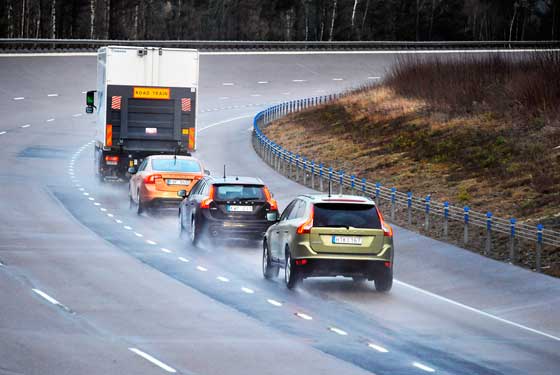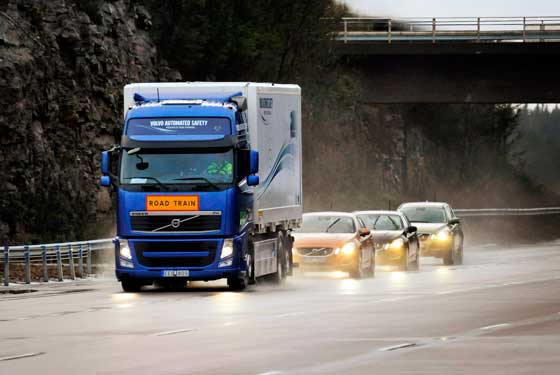‘Safe Road Trains for the Environment’ The SARTRE Project
The project in the the final phase of testing and demonstrating the Road Train concept with a multi vehicle platoon. The latest tests involve a lead truck and three cars driven autonomously at up to 90 km/h. The driverless cars enable a 20% saving in fuel. The passengers can then do other things. The road trains help promote safer transport, the lead vehicle is driven by a professional driver. Environmental impact is reduced as the cars slipstream and benfit from the lower drag. Road Capacity can therefore be used more efficiently.
Implementing Road Trains on Europe’s roads is not just a technical matter. Many discussions will be held with technical experts, politicians, legislators and traffic safety researchers. At past workshops a number of non-technical challenges for road trains were discussed, such as legal regulations, driver acceptance of automated vehicles and product liability. The huge project is being driven by Seven European Partners led by Ricardo Plc. It is the only highway project currently focused on developing new technologies that can be used on normal roads where platooned traffic can mix with other road users.
“The successful completion of the first multiple vehicle tests of the SARTRE system is a significant achievement,” commented SARTRE project director, Tom Robinson of Ricardo UK. “This has allowed us to demonstrate the operation of SARTRE road train technology to key industry experts and to capture their responses, all of which were very encouraging. The demonstration system provides us with a solid foundation for further consideration of the challenges of bringing road trains to reality”.
“A challenge has been to develop reliable communication between the vehicles in the platoon. Vehicle to vehicle communication is essential to ensure safety at high speeds and short vehicle spacing, “ says Carl Bergenhem, SP Technical Research Institute of Sweden.
About the SARTRE Project
SARTRE aims to encourage a step change in personal transport usage through the development of safe environmental road trains (platoons). Systems are being developed in prototype form that will facilitate the safe adoption of road trains on un-modified public highways with full interaction with non-platoon vehicles.
The project is addressing the three cornerstone transportation issues of environment, safety and congestion while at the same time encouraging driver acceptance through the prospect of increased “driver comfort”. The objectives of SARTRE may be summarised as:
1. To define a set of acceptable platooning strategies that will allow road trains to operate on public highways without changes to the road and roadside infrastructure.
2. To enhance, develop and integrate technologies for a prototype platooning system such that the defined strategies can be assessed under real world scenarios.
3. To demonstrate how the use of platoons can lead to environmental, safety and congestion improvements.
4. To illustrate how a new business model can be used to encourage the use of platoons with benefits to both lead vehicle operators and to platoon subscribers.
If successful, the benefits from SARTRE are expected to be significant. The estimated fuel consumption saving for high speed highway operation of road trains is in the region of 20 percent depending on vehicle spacing and geometry. Safety benefits will arise from the reduction of accidents caused by driver action and driver fatigue. The utilization of existing road capacity will also be increased with a potential consequential reduction in journey times. For users of the technology, the practical attractions of a smoother, more predictable and lower cost journey which offers the opportunity of additional free time will be considerable. The SARTRE project formally started in September 2009 and will run for a total of three years.
For more information visit The Sartre Project Here


